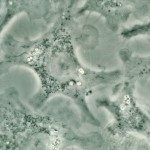Link to Pubmed [PMID] – 22370163
J Proteomics 2012 May;75(9):2536-49
Invasive aspergillosis (IA) is a major threat for immunocompromised patients. Diagnostic difficulties often delay specific treatment initiation, which increases mortality. Finding new biomarkers to improve and speed accurate diagnosis is thus vital. To investigate the ability of proteomic methods for discovering new biomarkers of IA, we used a DIGE approach to perform a proteomic analysis on both bronchoalveolar lavages (BAL) and sera at different time-points of infection in a mouse model of invasive pulmonary aspergillosis. Progression of the infection was monitored using a bioluminescent strain of Aspergillus fumigatus. Sera proteins were enriched using the ProteoMiner kit (Biorad). This method allowed us to identify a fungal protein, the A. fumigatus major allergen Asp f 2, in sera of mice one day after the infection. However, this fungal protein was not detected three days after the infection. Importantly, in BAL, this work provides evidence of an in vivo complement evasion mechanism through the cleavage of C3b into three fragments during aspergillosis. Finally, our results underlining the inflammatory host response to IA in both lung and blood compartments at different times of infection may provide new insights into the pathophysiology of this disease.
